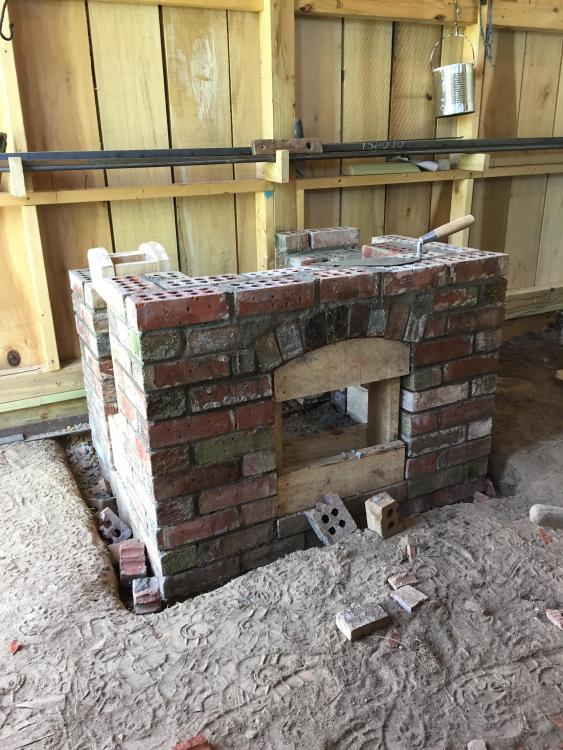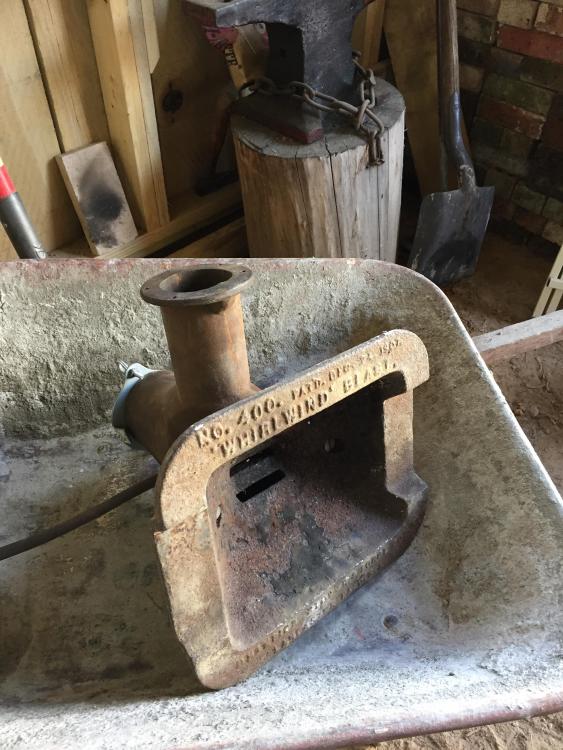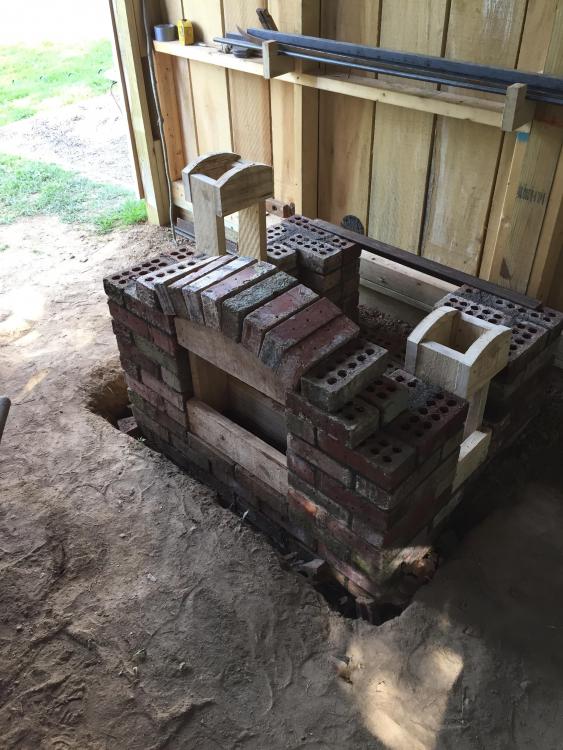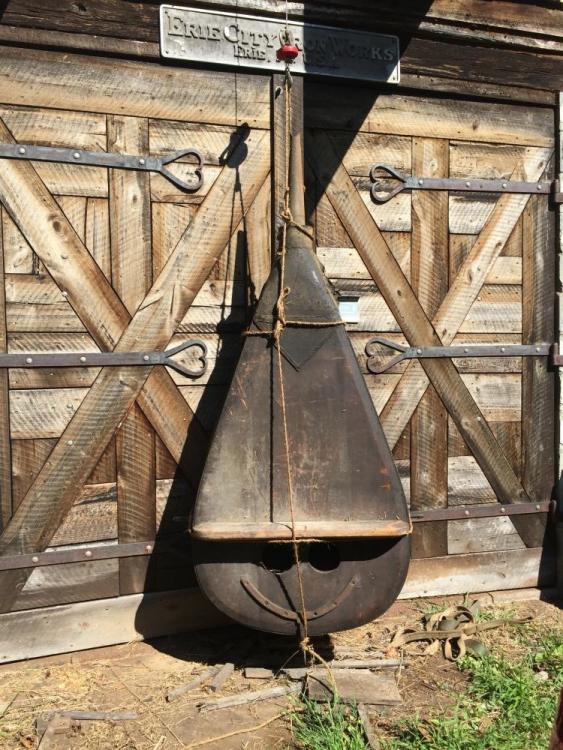-
Posts
90 -
Joined
-
Last visited
Content Type
Profiles
Forums
Articles
Gallery
Downloads
Events
Everything posted by David R.
-
I like that one!
-
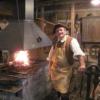
Craigslist Fisher just picked up? Whatya think?
David R. replied to King187's topic in Anvils, Swage Blocks, and Mandrels
Perhaps one of the reasons Fisher made such rash statements in their advertising was to counter all the negative things being said about their anvils by other manufacturers. I have heard the English manufacturers had lots of bold claims against these no good cast anvils. One of the shops I work in has an enormous Fisher. The owner of the museum had bought the thing years ago and thought he had gotten taken advantage of because it didn't ring. It was sitting outside where the roof dripped on it for years. We finally moved it inside and it is now in regular use. It is in almost pristine condition except for the surface pitting caused by exposure to the elements. It has excellent rebound but is quiet. I have a Hay Budden that does ring like a church bell! -
I need to be clarify. My floor is dry even when raining, but if I come into it out of the rain the dust sticks to the wet boots and then I have muddy feet going back to the house.
-
Dickb, I left a tall opening on the left side that allows easy access to the handle. I did have to bend and reshape the lever to get it to clear everything inside and allow full motion of the clinker breaker. I thought about extending it to outside the forge but figured I would be bumping into it then. Thanks for the input on the floor. I have a fine layer of powdery dust that seems to grow. If it is raining I end up with muddy feet and anything you drop is coated with dust. I didn't want a hard (concrete) floor because of issues I already have with my feet.
-
Hopefully it won't be too hot. I have a four foot wide door next to the forge and three windows I can open with dirt floor and no ceiling it should be tolerable.
-

Craigslist Fisher just picked up? Whatya think?
David R. replied to King187's topic in Anvils, Swage Blocks, and Mandrels
Fishers are good anvils and that one looks to be in great shape. They aren't as noisy as wrought anvils but usually have good rebound. Hope you get a lot of good use from it. -

Coal will not light...
David R. replied to ACforge's topic in Solid Fuels: Coal, Coke, Charcoal, Wood, etc
We were getting a real high quality met grade coal locally, picked up at the mine. Pea was NICE to forge with but nut worked good too. Mine closed. Recently found some of near the same quality, but what I call bug dust. (Size of bugs down to dust) with a little water it cokes off good but troublesome clogging up tuyre in bottom blast. Got access to some met grade nut coal, works real nice, will burn almost at forging heat with a natural draft. I have had fire go out on lunch break but with this stuff it will burn right on. A little higher ash content so have to pick clinkers more. Found mixing it with the bug dust works good. Most of my forging done with traditional forge set up, bottom blast and bellows or rivet forge and crank blower. -

Coal will not light...
David R. replied to ACforge's topic in Solid Fuels: Coal, Coke, Charcoal, Wood, etc
My hat is off to you anthricite users. I didn't mean to stir any ire, and I am sure there are differences in a coal as there is in b coal. The sack of anthricite I had I ended up burning in the coal stove but even then had to have a roaring hardwood fire going first and had to keep the air wide open and got very little heat output. I was glad to finally get rid of it. -

Coal will not light...
David R. replied to ACforge's topic in Solid Fuels: Coal, Coke, Charcoal, Wood, etc
I don't know how anyone can forge with that cursed anthracite, surely you'd freeze to death if you had to heat with it. Like trying to burn rocks! I have been spoiled with good pocahantas and sewell coal. I beleive I'd switch to charcoal if anthracite is all I could get. Really would be a joke to get that coal for Christmas -
Finally getting my forge built. Only wish I had made the building larger. Judiciouslly placed I think I will still be able to fit in a small bench and post vise, anvil, of course, post drill and bellows overhead. Any ideas for getting dirt floor packed down to cut down on dust?
-
Yes, those are doors to my blacksmith mentors shop, (my dream shop). He sometimes tends to over build, they should be good for the next 250 years. He let me store the bellows in his shop while I am building mine. Making some progress.
-
I hadn't thought about tailpipe. I have a friend with a muffler shop.
-
I am building a brick forge using a nice Champion 400 "whirlwind blast" tuyre. I plan to restore a large antique bellows to supply the air. I will have to hang the bellows overhead due to limited floor space. I am wondering what to use for air pipe. I know I don't want any galvanized metal around the fire, but could I use regular 3" stove pipe for the air supply?
-
Portable anvil stand. Got tired of dragging 150 pound anvils around for demos. Got this little Vulcan in a trade and decided to make a stand for it. No nails or fasteners. Gravity and the two wooden keys lock it all together. Made out of one wide poplar plank.
-
-
There are some basic rules of thumb for designing fireplace flues that should have some application for forge flue construction. If memory serves; The flue area should be at least 1/10 area of fireplace opening (or hearth opening for side draft forge) with chimney hieght of at least 15 ft. For shorter chimneys increase size of flue to 1/8. Throat should be 75% to 85% of flue area with offset or smoke shelf to reduce down drafts.
-
-
Long awaited blacksmith shop under construction. Picked up lumber for sheathing from mill Wednesday. My plan is to restore the antique bellows and mount overhead to save floor space.
-
My plan is to locate the belows overhead to save floorspace. This should help prevent heavier than air gas migrating to bellows and hopefully discourage rodents as well. The museum shop I forge in has a set up similar to the one pictured above. We seldom use much water, but what you said is true, keep the blast going while adding it. We had one incident a while back that was similar to a "town gas" explosion. The smith put a paper bag with some burned out candle stubs in the tuyre to start the fire. What we asumed must of happenend is all the parifin did not burn, but some of it melted into the bottom of the pot and then gassified. He had his back to the fire at his anvil and when I begin to pump we had a pretty good explosion with the prettiest blue halo of flame rolling up the chimney. He thought someone had fired a cannon. Luckily no damage was done.
-
Recently aquired this great bellows. My plan is to restore it and put it to use in my proposed shop. The wood is pretty much sound but of course all the leather will need replaced. I frequently get the opportunity to work a forge with a bellows similar to this one. I love them, and much prefer to a crank blower. Love to hear the soft clack of the valves and the natural rhythm. Anyone using bellows for forge work? Any tips on restoration?
-
Mark, good job on your first hawk. Here are what tips I can offer on welding: 1) Keep your fire clean. Keep the clinkers picked out. 2) Keep plenty of coke handy to poke down in the bottom of the fire as it burns out quick at welding heat. Keep fuel under your work. 3) I like to bring the work up to a dull red and wire brush. The scale will show up as dark spots and is easily removed with the brush. Then I flux with borax and go back to fire and gradually bring it up to welding heat. 4) Use wrought iron if you can find it. It forge welds so much easier than steel, but of course you have to add steel for cutting bit.
-
Had one just like the little round one with the hand crank and belt drive blower. It would blow the fire up fine if I had a good tight belt on it. Trouble was, mine had the air blast grate elevated a couple inches above the floor and you couldn't get enough depth in the fire for any heavy work. I sold it and got a little bigger one with a little deeper pot and a hand crank gear blower. Did blacksmith demos at a local festival a few days this fall with a lever ratchet belt drive forge. Got hard rains one day and the leather belt got wet and stretched out till I couldn't blow up the fire. I made it through the day by putting wood ash on it to get it to grip. Had to tear down and re-splice the belt the next morning.
-
What is railroad anchor? How did you harden and temper? Symmetry is excellent. Did you use swage or die?
-
Here are a couple hawks I welded up with wrought iron wrapped and forge weld started then a piece of plow steel sandwiched in for a bit. The one with the darker handle is the first one I did and I have intentionally abused it to see if it would hold up. I believe it is just about indestructible. I think the taper on the eye and shape is better on number two, but I believe they both will be good axes. I drew the temper maybe just a little harder than normal for an axe but with the wrought laminated either side of the steel I think it will work ok. Hickory handles.
-
Found this old anvil sitting in the yard of a local antique store. I would have left it if it hadn't been real cheap, but amazingly it still has a good rebound. I thought at least it would be good for a floor anvil to jump long rods on to upset. The shop proprietor said it was found under a collapsed barn. It looks cast but has a steel face and has really good rebound! Doesn't look like a Fisher does it?

